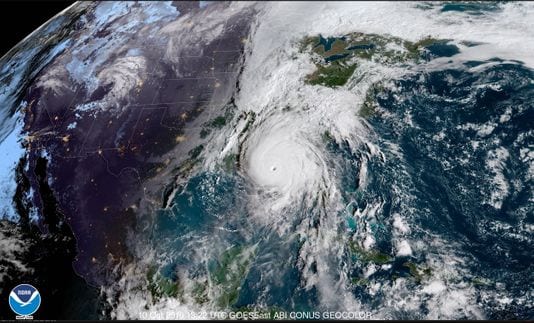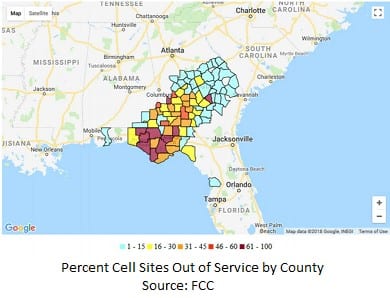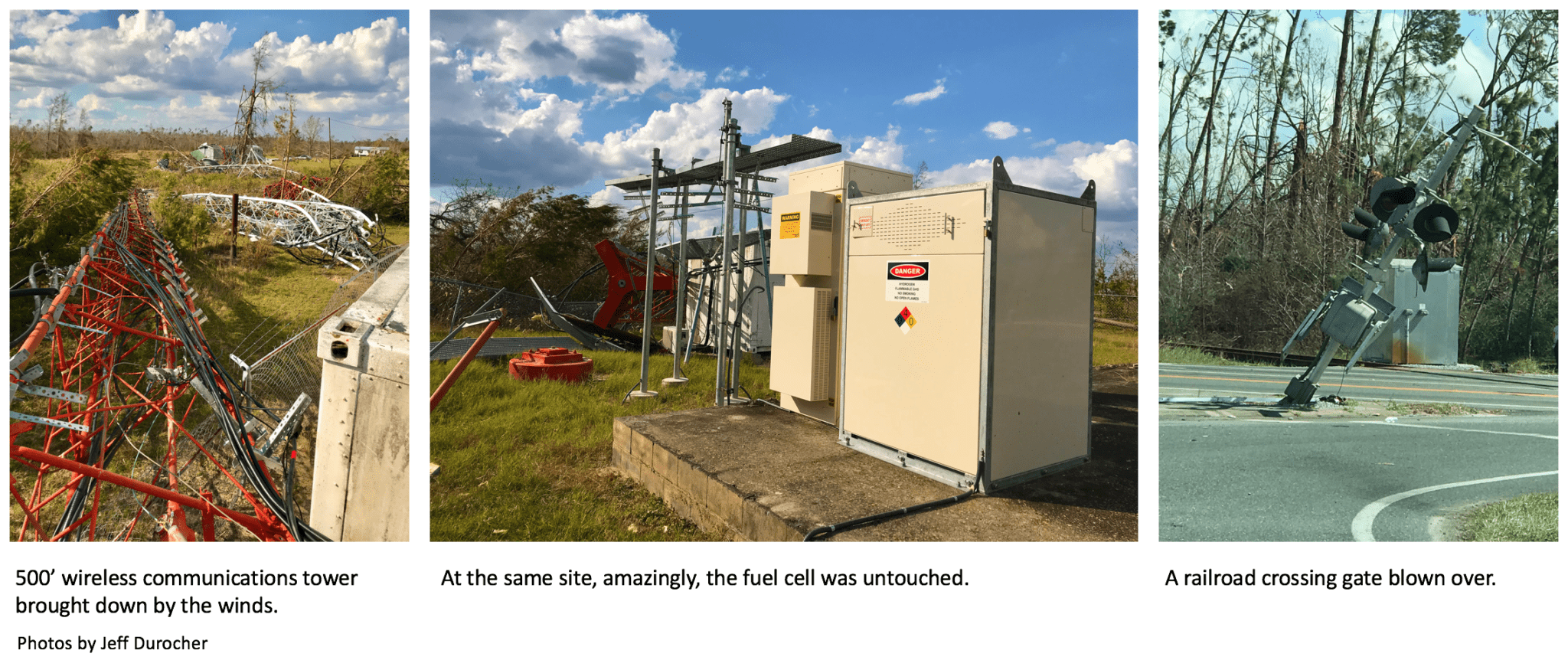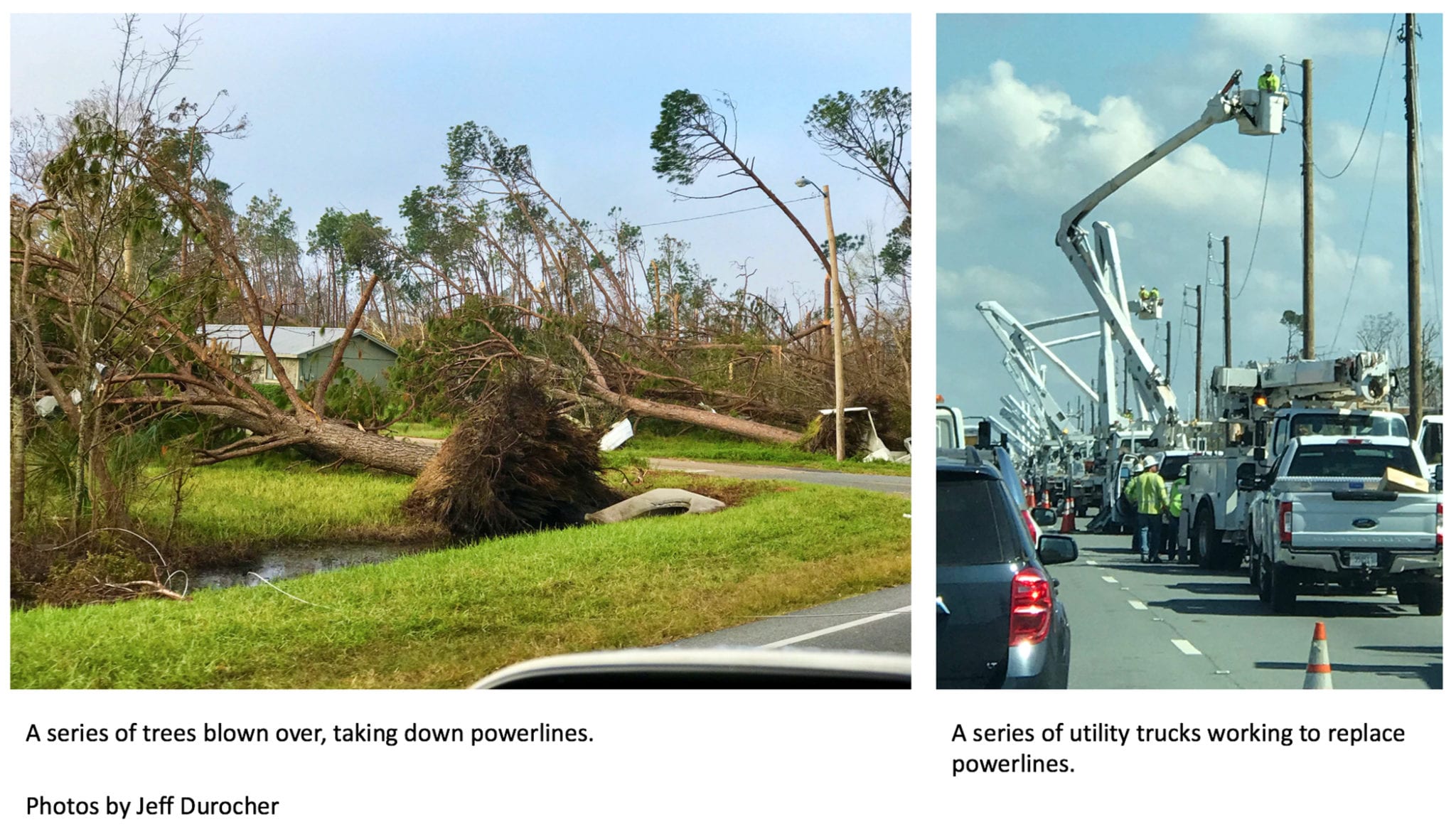Recovering from Michael
How Hydrogen Fuel Cells Kept Critical Communications Infrastructure Working During a Severe Natural Disaster
Fourteen-foot storm surges. Tens of thousands of people unable to evacuate. Buildings collapsing in Panama City. Mexico Beach obliterated. RVs tossed through the air like toys; roofs peeled off motels and houses like sardine-can lids. Hurricane Michael came ashore on October 10, 2018 as the strongest hurricane in history—since record keeping began in 1851—to hit the Florida panhandle and across the southeast, leaving millions without power. The storm’s peak winds upon landfall were the fourth-highest on record for the continental United States and reached a jaw-dropping 155 MPH.
Through the storm’s devastation, the need for critical communication cannot be overstated. Michael sheared off trees, which knocked down utility power lines along its path, taking out the primary power source to this communications equipment. To prepare for disasters like this, telecommunications, utility telecom, and railroad communications providers supply their equipment with backup power – power that takes over when the grid is down. Plug Power’s GenSure fuel cells were on the front lines, ready to serve when the storm roared through.
Hurricane Michael’s Impact on Power and Communications
NPR reported that nearly 400,000 electricity accounts had lost power in Florida as of noon Eastern Thursday October 11, 2018 – and up to 1.7 million electricity customers across six states, according to situation reports from the U.S. Department of Energy’s Office of Cybersecurity, Energy Security, and Emergency Response. Among the hundreds of thousands of homes and businesses impacted were thousands of cell towers responsible for critical communications for 911 workers, hospitals, police and firefighters.
FCC Chairman Ajit Pai reported data from the agency’s Disaster Information Reporting System (DIRS) showing that Hurricane Michael caused “substantial communications outages along its destructive path.” Employees from Pai’s office and the Public Safety and Homeland Security Bureau contacted carriers and broadcasters to assess the situation to discuss how to restore service as quickly as possible.
- Florida had the most cell site outages, according to the first report. Out of 2,543 cell sites, 733 (or 28.8 percent) were not working. Eight out of Liberty County’s nine cell sites were out, or nearly 90 percent. Bay County followed, with 256 out of 327 cell sites out, or just over 78 percent.
- In Georgia, 554 out of a total of 3,910 sites were out – or just over 14 percent. Schley County had the most outages by percentage, with six out of nine cell sites not operational, or 66.9 percent. Grady County followed, with 26 out of 42 sites not operational, or just under 62 percent.
- In Alabama, out of 759 cell sites, 70 were not working, or just over nine percent. Henry County was affected the most, with 17 out of 38 sites impacted, or more than 44 percent.
Putting the power lines back together is a monumental task. The Washington Post reported that 17,000 utility workers arrived to rebuild and repair the disrupted and destroyed power infrastructure. As of October 23, 2018, AGL Magazine reported that the number of cable and wireline subscribers still out of service in the affected areas was just over 55,000, while the number of wireless telecom sites still experiencing outages was down to 5.2 percent. Clearly, there have been a lot of people going above and beyond the call of duty to help this region begin to recover. While it will be weeks and months – perhaps even years – until all homes and businesses will be rebuilt, power and communications are well on their way to recovery.
Plug Power’s Experience with Michael
The story of Hurricane Michael from Plug Power’s experience has been one of disaster recovery. In all, 49 of our fuel cells were called upon to operate during the storm, and all 49 answered the call – with a couple still operating, as crews continue their work to complete power and infrastructure repairs. We were on the ground for a week, assisting with site repair efforts and were overwhelmed with the devastation –
– and also the heroics involved with recovery efforts.
Sites where wireless cell towers were destroyed are obviously incapable of transmitting signals. It will be a long time before those sites will be operational again. But at most of the fuel cell-powered sites, damage was only to the utility power lines serving the sites. In those instances, the fuel cells provided – or are still providing – backup power to keep critical telecommunication lines operational until the work to repair the utility infrastructure could be completed.
In all, Plug Power’s GenSure fuel cells have provided more than 2,390 run-hours of backup power – with two sites having run continuously for over 15 days. Crews worked quickly to clear roads and access points and the sites experienced no supply issues; no fueling issues. The length of time served by each fuel cell was primarily determined by how quickly the primary utility power was restored. Our fuel cells ran anywhere between 3 hours and 365+ hours, with most clustered between 12 and 66 hours. Hydrogen refueling was provided as needed by our own GenFuel hydrogen team. We are honored that our fuel cell products have been able to help the Southeast begin to recover from this massive storm.
Natural disasters like Hurricane Michael cannot be prevented. They happen each year worldwide. The only variables are location and severity. While a true disaster happens very infrequently in any given location, shorter outages needing backup power happen more often. By utilizing backup power solutions in conjunction with a disaster recovery refueling plan, a critical communications provider has the ability to cost-effectively address both needs. When a carrier is prepared, they can focus on the myriad recovery efforts needed when disaster strikes – instead of worrying about whether their critical communications equipment is functioning.
#InfiniteDrive
The post Recovering from Michael appeared first on Plug Power.



